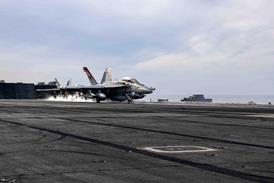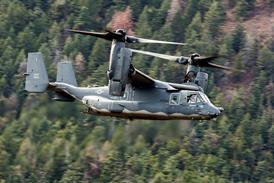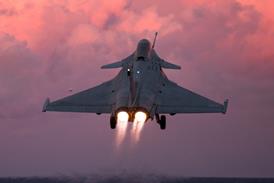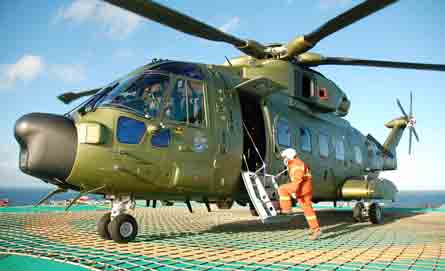Denmark is the first Nordic nation to receive multi-role helicopters under a regional renewal. Flight International was aboard for its latest EH101 delivery
Almost a decade ago, the four Nordic states embarked on a process to transform their rotorcraft fleets with modern platforms suitable for more than the nation defence tasks of the Cold War. Although the planned Joint Nordic Helicopter competition failed to lead to a co-operative procurement, each country placed orders early this decade for a combined total of 66 multi-role aircraft, the first of which were delivered this year.
|
|---|
Early Joint Supporters will conduct search and rescue tasks |
Two European types will be used to meet the various requirements of Denmark, Finland, Norway and Sweden for anti-submarine warfare, troop transport and search-and-rescue (SAR) activities: the AgustaWestland EH101 and NH Industries' NH90. Deliveries of the latter type have yet to begin, leaving Denmark with the distinction of having introduced the first aircraft under the procurements.
Twelve of the Royal Danish Air Force's (RDAF) 14 EH101s - which are also referred to as Danish Multi-Role Helicopters or Joint Supporters - have been flown to the service's Karup airbase, 70km (38nm) west of Arhus. The fleet has been manufactured to an identical standard, but the first eight have received a range of role equipment that will support their use for dedicated SAR duties. The rest will perform tactical troop transport (TTT) missions, with the last two to be delivered by next month.
|
|---|
M-512's delivery route included landing on Danish oil rig. |
Easily distinguished by the luminous yellow stripe on their central fuselages, the SAR aircraft will be brought into operational use early next year, when they will begin to replace Denmark's seven remaining Sikorsky S-61 Sea Kings. An earlier delay to the project has forced Copenhagen to extend operations of its 40-year-old S-61s, but 722 Sqn instructor pilot Lt Jørn Eilersen says the new type will begin performing patrols from March, with S-61 operations now scheduled to end in 2008. Seven Danish instructors have so far converted to the EH101 and the nation's first students will begin training on the type next February.
New capability
The tactical transport acquisition represents a new capability for the RDAF, and Tactical Air Command Denmark (TACDEN) is assessing its future operational requirements for the type. The air force's first students to convert to the type will begin training in 2008, and the six-strong fleet is to achieve full operational status in 2009-10, says TTT flight commander Capt Søren Bak Sørensen.
However, the latter schedule could be pushed back if the Danish defence ministry opts to accept a proposal to transfer six aircraft from its acquisition to bolster the number of support helicopters available to the UK Royal Air Force's 28 Sqn, which currently operates 22 EH101 Merlin HC3s. Co-operation between the nations' air forces is already considerable, with a Danish pilot recently completing an exchange tour with the RAF Merlin force in southern Iraq and an RAF instructor having converted on the Joint Supporter.
Danish instructors have so far received 40h of simulator-based training at the UK's CAE Aircrew Training Services-run Medium Support Helicopter Aircrew Training Facility at RAF Benson, with future instructors and students on the type to receive 20h a year. Although the RAF's Merlins were built to an earlier production standard and have an older cockpit configuration with fewer multifunction displays, its synthetic devices for the type still provide a useful training capability, says the RDAF.
Danish officials are quick to note that should the nation's government accept the UK request, AgustaWestland would produce a further six aircraft to meet its long-term requirements. Denmark is also looking closely at the UK's operational experience with the Merlin HC3 to influence its future activities with the Joint Supporter. "TACDEN has to decide which roles the TTT will undertake, but we realistically expect to do what [the RAF's] 28 Sqn does," says Jan Nielsen, the Danish Air Materiel Command's qualification and acceptance manager for the EH101.
With a decision yet to be taken on a possible aircraft transfer, the RDAF is continuing preparations to receive its last EH101 by 17 January. The schedule would see all 14 aircraft handed over within 12 months and the overall programme deliver its final aircraft from AgustaWestland's Yeovil manufacturing site in the UK one year late. This acceleration of deliveries from an original 18-month plan would claw back part of the delay experienced in the development and initial production phase, says Nielsen. "The programme was more complex than we expected, and our schedule was probably unrealistic," he says, while noting that the RDAF's unique configuration requirements also contributed to the delay.
Denmark's aircraft differ from previous production examples in having an alternate gross weight (AGW) of 14,600-15,600kg (32,200-34,400lb), which David Beddows, AgustaWestland's head of export programmes for the type, says makes it "the GTi of EH101s". All Danish aircraft have an identical communications fit, Honeywell enhanced ground proximity warning system and a non-tactical datalink that could be used to relay imagery captured during SAR missions, but could later be replaced by a Link 11 capability for deployed operations. The Danish configuration can easily be distinguished from previous EH101s by its nose radome, which houses a Telephonics RDR1600 weather radar, and by its use of a reduced infrared signature paint scheme.
Denmark's SAR helicopters will fly with a crew of six, including one operator for the aircraft's communications equipment and nose-mounted FLIR Systems Star Safire II electro-optical/infrared (EO/IR) sensor. Other role equipment for the type includes two hoists, a patient treatment area akin to an air ambulance specification, and an autopilot capable of flying automatic search patterns. It also has four rear crew seats - a characteristic that has already resulted in the type being called into action to fly VIP transport missions.
Coupled with its long endurance, the EH101's high speed will be a major asset in SAR missions. Its cruise speed of 120kt (220km/h) above 14.6t is the same as the S-61's normal maximum, but this figure rises to about 150kt below AGW, significantly bettering the older type's brief burst speed of up to 140kt. "The autopilot will be a huge improvement over the S-61, as will the anti-icing system," says Nielsen. The RDAF typically flies 600 SAR missions a year from three sites, with duties such as patient transfers from small islands accounting for around half this total.
The TTT platform has been equipped with a nose-housed Marconi obstacle warning system, which provides visual and audio warnings of an object up to 13s from the calculated time of impact. The air force says this has proved over-sensitive when the aircraft is flown at low level, and an upgrade could later be sought to reduce ground returns. However, it says the current system could be used to enhance safety during SAR operations over water.
Paradrop missions
The transport version has 16 troop seats and a fixed ceiling rail for paradrop missions, and fast roping is possible from hooks at its cargo door and tail ramp. The type lacks the SAR platform's EO/IR sensor, but 722 Sqn plans to equip these with Star Safire I systems, to be sourced from its retired S-61s as an interim measure. The TTT aircraft carry electronic warfare equipment in the form of radar warning receivers, radio frequency jammers and countermeasures dispensers, and can also be equipped with cabin armour and pintle-mounted machine guns. The RDAF has also acquired one in-flight refuelling probe for its EH101 fleet and will study the possibility of its future use.
Flight International was invited to join the RDAF crew delivering the service's newest Joint Supporter - M-512 - from Yeovil to Karup on 17 November, following its formal handover after a customer acceptance flight lasting about 2h the previous day. The Danish acceptance process comprises a two-week inspection by about eight air force personnel and remedial action by AgustaWestland before final shakedown flight trials by an RDAF crew.
Early production examples were flown to Karup via a refuelling stop in the Netherlands, but the RDAF's last six arrivals travelled directly from Yeovil across the North Sea, with M-512 also performing a brief touchdown on an oil rig during its 4h 25min sortie.
This mission endurance is made possible only by shutting down and placing in neutral the aircraft's third Rolls-Royce Turbomeca RTM322 engine after about 2h of flight, which the air force says cuts the EH101's fuel consumption from around 750kg an hour to 600-650kg.
With almost 800 flight hours with the Joint Support behind it, the RDAF is nearing the one-third stage of an anticipated 3,000 operating hours before the type's entry into full service, and is so far satisfied with the aircraft's performance. "It's easy to fly and handles like a lighter aircraft," says Eilersen. The service is changing one part on the tail rotor after every 100 flight hours following a cracking problem experienced with other EH101s, but intends to increase this interval over time, or adopt a replacement design now in test.
A follow-on requirement to acquire new maritime helicopters for the Danish navy has been deferred, but the EH101 and NH90 could be lead candidates.
Read Craig's blog - Bringing home the bacon: delivering Denmark’s latest EH101
Source: Flight International

























